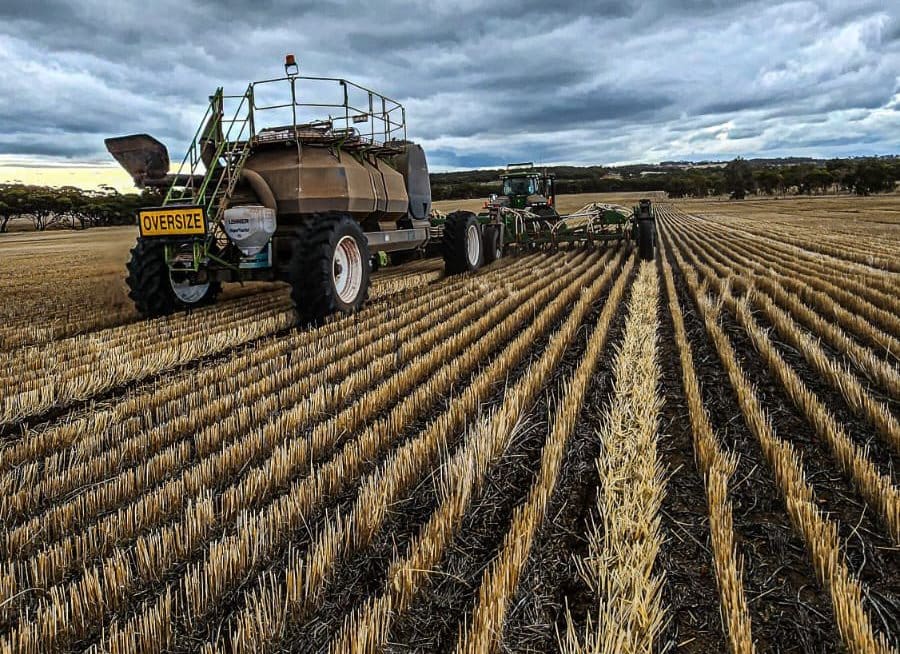
Liquid fertiliser being applied at seeding at Waddi Park in WA. Photo: Trevor Syme
RAINFALL still dominates decisions around fertiliser use for Western Australian grain growers, but logistics are playing an increasing role, according to a recent survey.
While nitrogen decisions are most sensitive to agronomic factors, especially the amount and distribution of rainfall, logistic factors are becoming increasingly important.
The University of Western Australia, WA Department of Primary Industries and Development and Murdoch University-led study noted the growing influence of factors such as rainfall patterns, cropping areas and the number of fertiliser applications within seasons.
The researchers also reported that increased farm size and cropping areas see growers experiencing
difficulties keeping fertiliser up to machinery at seeding, and this is likely to be restricting fertiliser
rates.
The ratio of nitrogen fertiliser to grain price has spiked since the 2020 survey which found that, over
the last 10 to 15 years, growers are less influenced by input price, grain price and profit/yield
objectives.
The survey revealed that environmental factors have little influence on fertiliser decision-making in
areas of low rainfall for dryland cropping systems.
Study leader Dr Elizabeth Petersen said that was possibly due to Australia’s comparatively low
fertiliser N use “due to low nitrogen demand by dryland crops and the lack of subsidies on crops or
fertilisers that promote overuse.”
The researchers undertook phone interviews with 425 grain businesses across the Albany, Esperance, Geraldton and Kwinana port zones — representing 11 percent of all WA grain businesses – in September 2020.
The average arable farm area was 3488 ha, of which an average of 73pc was cropped each year.
A total of 83pc of respondents indicated that they managed the farm 10-15 years ago.

Dr Liz Petersen.
For these respondents, the proportion of the farm cropped has increased by 12pc over this period.
Survey respondents applied nitrogen fertiliser an average 2.2 times in a season. This has increased
from an average of 1.6 applications 10-15 years ago.
Despite over three-quarters of survey respondents reporting decreasing growing-season rainfall over
the last 10 to 15 years, fertiliser nitrogen rates had increased by 24pc from 48 to 60kg N/ha.
The researchers suggested this could be due to the decrease of legume cropping and greater water-use
efficiency.
Producers are spending marginally more time planning their N fertiliser use, but the researchers
added: “Despite fertiliser being, for many producers, the single biggest variable cost item in their
farm budget this study suggests that producers are not spending significant time on their nitrogen
fertiliser strategies.”
Perhaps producers think it is not worth the effort; as the researchers admitted: “In many cases, large
deviations from optimal decisions make little difference to profitability.”
Most respondents indicated they have all the data they need to make effective fertiliser decisions,
with the most important data sources being soil tests, especially of topsoil, plant-tissue testing,
yield mapping, and understanding grain-protein levels in the previous crop.
However, 19pc of respondents indicated they lacked the time or resources to access sufficient data.
“The aim of this study was to understand the factors that have the greatest influence on grain producers’ fertiliser strategies and how these factors have changed over recent years,” Dr Petersen said.
“Factors affecting fertiliser decisions made by grain growers are changing in the context of changing
climatic conditions and growing volatility in global fertiliser and grain markets.”
Other researchers involved in the study were: Craig Scanlan; Michael Burton; Yvette Oliver; Daniel Murphy, and Frances Hoyle.
Grain Central: Get our free news straight to your inbox – Click here

HAVE YOUR SAY